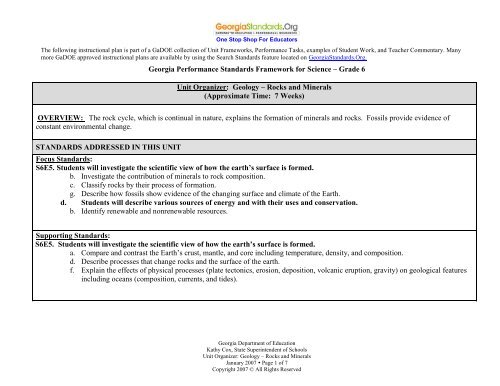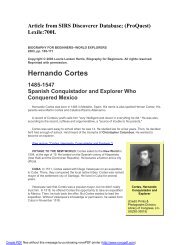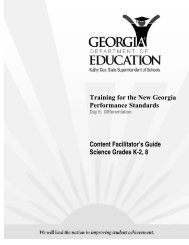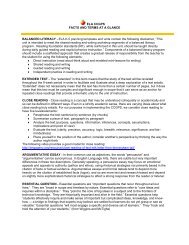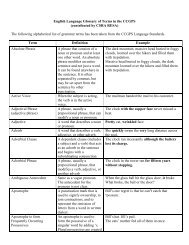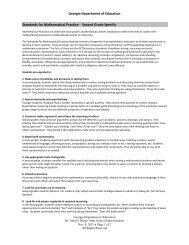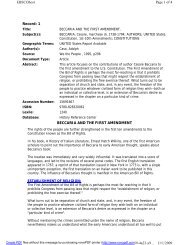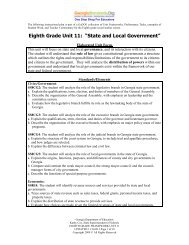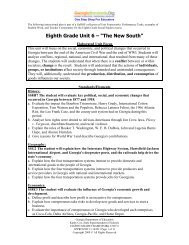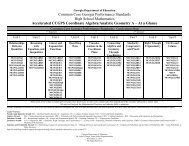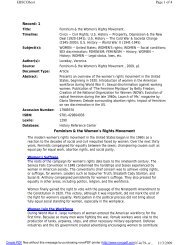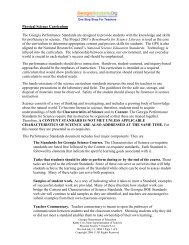Rocks and Minerals - GeorgiaStandards.org
Rocks and Minerals - GeorgiaStandards.org
Rocks and Minerals - GeorgiaStandards.org
Create successful ePaper yourself
Turn your PDF publications into a flip-book with our unique Google optimized e-Paper software.
One Stop Shop For Educators<br />
The following instructional plan is part of a GaDOE collection of Unit Frameworks, Performance Tasks, examples of Student Work, <strong>and</strong> Teacher Commentary. Many<br />
more GaDOE approved instructional plans are available by using the Search St<strong>and</strong>ards feature located on Ge<strong>org</strong>iaSt<strong>and</strong>ards.Org.<br />
Ge<strong>org</strong>ia Performance St<strong>and</strong>ards Framework for Science – Grade 6<br />
Unit Organizer: Geology – <strong>Rocks</strong> <strong>and</strong> <strong>Minerals</strong><br />
(Approximate Time: 7 Weeks)<br />
OVERVIEW: The rock cycle, which is continual in nature, explains the formation of minerals <strong>and</strong> rocks. Fossils provide evidence of<br />
constant environmental change.<br />
STANDARDS ADDRESSED IN THIS UNIT<br />
Focus St<strong>and</strong>ards:<br />
S6E5. Students will investigate the scientific view of how the earth’s surface is formed.<br />
b. Investigate the contribution of minerals to rock composition.<br />
c. Classify rocks by their process of formation.<br />
g. Describe how fossils show evidence of the changing surface <strong>and</strong> climate of the Earth.<br />
d. Students will describe various sources of energy <strong>and</strong> with their uses <strong>and</strong> conservation.<br />
b. Identify renewable <strong>and</strong> nonrenewable resources.<br />
Supporting St<strong>and</strong>ards:<br />
S6E5. Students will investigate the scientific view of how the earth’s surface is formed.<br />
a. Compare <strong>and</strong> contrast the Earth’s crust, mantle, <strong>and</strong> core including temperature, density, <strong>and</strong> composition.<br />
d. Describe processes that change rocks <strong>and</strong> the surface of the earth.<br />
f. Explain the effects of physical processes (plate tectonics, erosion, deposition, volcanic eruption, gravity) on geological features<br />
including oceans (composition, currents, <strong>and</strong> tides).<br />
Ge<strong>org</strong>ia Department of Education<br />
Kathy Cox, State Superintendent of Schools<br />
Unit Organizer: Geology – <strong>Rocks</strong> <strong>and</strong> <strong>Minerals</strong><br />
January 2007 • Page 1 of 7<br />
Copyright 2007 © All Rights Reserved
One Stop Shop For Educators<br />
Ge<strong>org</strong>ia Performance St<strong>and</strong>ards Framework for Science – Grade 6<br />
ENDURING UNDERSTANDINGS<br />
Students will underst<strong>and</strong> that:<br />
Many materials used by people come from rocks <strong>and</strong> minerals.<br />
<strong>Rocks</strong> are classified based on how they formed <strong>and</strong> their mineral composition.<br />
Sedimentary rocks are formed by the ongoing deposition of rocks <strong>and</strong> other sediments that are cemented together.<br />
Fossils, the remains of <strong>org</strong>anisms preserved in sedimentary rocks, are part of the evidence scientists use to infer changing conditions at the<br />
Earth’s surface through time<br />
<strong>Rocks</strong> at the Earth’s surface weather, forming sediments that are buried, then compacted, heated, <strong>and</strong> often recrystallized into new rock.<br />
ESSENTIAL QUESTIONS:<br />
Topical Essential Questions:<br />
How are minerals identified?<br />
How are rocks formed?<br />
How are rocks classified?<br />
How can rocks change from one type to another?<br />
Is the rock cycle really a cycle? Explain your answer.<br />
How do natural objects compare to manufactured objects?<br />
How are rocks <strong>and</strong> minerals used by 6 th graders?<br />
Ge<strong>org</strong>ia Department of Education<br />
Kathy Cox, State Superintendent of Schools<br />
Unit Organizer: Geology – <strong>Rocks</strong> <strong>and</strong> <strong>Minerals</strong><br />
January 2007 • Page 2 of 7<br />
Copyright 2007 © All Rights Reserved
One Stop Shop For Educators<br />
Ge<strong>org</strong>ia Performance St<strong>and</strong>ards Framework for Science – Grade 6<br />
KNOWLEDGE:<br />
Sedimentary, igneous, metamorphic, rock composition, mineral formation, pressure, rock cycle,<br />
<strong>Minerals</strong> can be identified by their physical properties.<br />
Igneous rocks are dominated by silicate minerals.<br />
<strong>Rocks</strong> are composed of minerals. <strong>Minerals</strong> are the building blocks of rocks.<br />
The rock cycle explains how one rock type can be transformed into another. This process is continuing today.<br />
Magma cools <strong>and</strong> crystallizes to form igneous rock.<br />
Igneous rock undergoes weathering (or breakdown) to form sediment. The sediment is transported <strong>and</strong> deposited somewhere (such as at<br />
the beach or in a delta, or in the deep sea).<br />
Usually after burial, the deposited sediment undergoes lithification (the processes that turn it into a rock). This includes cementation <strong>and</strong><br />
compaction.<br />
If the sedimentary rock is buried deep in the crust under more <strong>and</strong> more sediment, often due to plate tectonic movements, the heat <strong>and</strong><br />
pressure causes metamorphism to occur. This transforms the sedimentary rock into a metamorphic rock.<br />
As the metamorphic rock is buried more deeply, temperatures <strong>and</strong> pressures continue to rise. If the temperature becomes hot enough, the<br />
metamorphic rock undergoes melting. The molten rock is called magma. This completes the cycle.<br />
Any rock type can undergo weathering to form sediment. Igneous, metamorphic <strong>and</strong> sedimentary rocks undergo weathering.<br />
Igneous rocks can undergo metamorphism (as a result of heat <strong>and</strong> pressure) to form metamorphic rocks.<br />
CONCEPTS:<br />
Processes that form the Earth/rocks, evidence of change<br />
LANGUAGE:<br />
Sedimentary, igneous, metamorphic, rock composition, mineral formation, pressure, rock cycle<br />
Ge<strong>org</strong>ia Department of Education<br />
Kathy Cox, State Superintendent of Schools<br />
Unit Organizer: Geology – <strong>Rocks</strong> <strong>and</strong> <strong>Minerals</strong><br />
January 2007 • Page 3 of 7<br />
Copyright 2007 © All Rights Reserved
One Stop Shop For Educators<br />
Ge<strong>org</strong>ia Performance St<strong>and</strong>ards Framework for Science – Grade 6<br />
MISCONCEPTIONS :<br />
All rocks are the same <strong>and</strong> it's hard to tell how they originated.<br />
<strong>Rocks</strong> <strong>and</strong> minerals are the same thing <strong>and</strong> distinguishing them is not<br />
important.<br />
Humans can fabricate rocks <strong>and</strong> minerals; artifacts are the same as<br />
rocks or minerals.<br />
You can test the hardness of a mineral (such as a diamond) by hitting<br />
it with a hammer.<br />
The Stone Mountain granite underlies all of Ge<strong>org</strong>ia, or underlies<br />
several states.<br />
<strong>Minerals</strong> are not important to my life.<br />
All rocks are the same <strong>and</strong> it’s hard to tell how they originated.<br />
<strong>Rocks</strong> <strong>and</strong> minerals are the same thing <strong>and</strong> distinguishing them is not<br />
important.<br />
Human’s can fabricate rocks <strong>and</strong> minerals; artifacts are the same as<br />
rocks or minerals.<br />
PROPER CONCEPTIONS<br />
<strong>Rocks</strong> can be distinguished into many different types, based on their<br />
origins <strong>and</strong> compositions.<br />
<strong>Rocks</strong> <strong>and</strong> minerals are not the same thing; rocks are composed of<br />
minerals which are naturally existing chemical compounds.<br />
<strong>Rocks</strong> <strong>and</strong> minerals are naturally occurring substances that are usually<br />
crystalline <strong>and</strong> solid.<br />
Hardness is tested by scratching.<br />
The Stone Mountain granite is a relatively small granite pluton that<br />
covers an area less than a county in size.<br />
Almost every product we use in daily life contains depends on<br />
minerals that have to be mined.<br />
<strong>Rocks</strong> can be distinguished into many different types, based on their<br />
origins <strong>and</strong> compositions.<br />
<strong>Rocks</strong> <strong>and</strong> minerals are not the same thing; rocks are composed of<br />
minerals which are naturally existing chemical compounds.<br />
<strong>Rocks</strong> <strong>and</strong> minerals are naturally occurring substances that are usually<br />
crystalline <strong>and</strong> solid.<br />
Ge<strong>org</strong>ia Department of Education<br />
Kathy Cox, State Superintendent of Schools<br />
Unit Organizer: Geology – <strong>Rocks</strong> <strong>and</strong> <strong>Minerals</strong><br />
January 2007 • Page 4 of 7<br />
Copyright 2007 © All Rights Reserved
One Stop Shop For Educators<br />
Ge<strong>org</strong>ia Performance St<strong>and</strong>ards Framework for Science – Grade 6<br />
EVIDENCE OF LEARNING:<br />
By the conclusion of this unit, students should be able to demonstrate the following competencies:<br />
Culminating Activity:<br />
<strong>Rocks</strong> And <strong>Minerals</strong> Culminating Activities<br />
Goal: Plan <strong>and</strong> describe a rock, mineral, <strong>and</strong> fossil collection which could be made from materials in your county plus two other selected<br />
Ge<strong>org</strong>ia counties.<br />
Role: A middle school student called on to assist in developing a collection.<br />
Audience: Your school science department.<br />
Situation: Your teacher needs a class set of teaching specimens of 8 different rock types (including sedimentary, igneous, <strong>and</strong> metamorphic<br />
examples), 4 fossils representing a variety of ages <strong>and</strong> environments of origin, <strong>and</strong> 1 nonrenewable energy resource. Using the Lawton (1977)<br />
Geologic Map of Ge<strong>org</strong>ia, you will determine the extent to which these needs can be supplied from your own county. Then identify two other<br />
counties from which samples would allow you to complete the collection.<br />
Product: A description of the items in the proposed collection <strong>and</strong> the county of origin of each. For each rock, provide information on the<br />
minerals that make it up, as well as how it formed as an igneous, sedimentary, or metamorphic rock. For each fossil, tell how old it is <strong>and</strong> in<br />
what kind of environment the <strong>org</strong>anism lived. For the energy resource, explain how it formed <strong>and</strong> why it is considered nonrenewable.<br />
St<strong>and</strong>ard: See rubric<br />
Ge<strong>org</strong>ia Department of Education<br />
Kathy Cox, State Superintendent of Schools<br />
Unit Organizer: Geology – <strong>Rocks</strong> <strong>and</strong> <strong>Minerals</strong><br />
January 2007 • Page 5 of 7<br />
Copyright 2007 © All Rights Reserved
One Stop Shop For Educators<br />
Ge<strong>org</strong>ia Performance St<strong>and</strong>ards Framework for Science – Grade 6<br />
Geology<br />
<strong>Rocks</strong> <strong>and</strong> <strong>Minerals</strong><br />
GRASPS – Rubric<br />
Scientific<br />
Information<br />
Rock<br />
processes of<br />
formation<br />
Mineral<br />
composition<br />
of rocks<br />
Fossils as<br />
evidence of<br />
change<br />
Renewable<br />
<strong>and</strong> nonrenewable<br />
energy<br />
Description of each rock’s<br />
origin is detailed <strong>and</strong><br />
substantially accurate.<br />
The project provides<br />
substantially accurate<br />
information on the mineral<br />
composition of every rock in<br />
the collection.<br />
4 3 2 1<br />
All fossils are correct as to age<br />
<strong>and</strong> location. The description<br />
of the environment contains<br />
some detail <strong>and</strong> is<br />
substantially accurate.<br />
The project accurately<br />
describes the location <strong>and</strong><br />
formation of Ge<strong>org</strong>ia’s nonrenewable<br />
energy resource.<br />
The igneous, sedimentary,<br />
or metamorphic origin of<br />
each rock is correct, <strong>and</strong><br />
there is some additional<br />
accurate description of the<br />
rocks’ origins.<br />
The project accurately<br />
identifies at least one<br />
mineral in each rock in the<br />
collection.<br />
All fossils are listed<br />
correctly as to age,<br />
location <strong>and</strong> marine or<br />
terrestrial origin, but no<br />
further accurate details are<br />
given.<br />
The project correctly<br />
identifies the resource <strong>and</strong><br />
contains some accurate<br />
details as to its formation<br />
<strong>and</strong> location.<br />
The igneous, sedimentary, or<br />
metamorphic origin of each<br />
rock is correct, but there is<br />
little or no additional accurate<br />
description of the rocks’<br />
origins.<br />
The project contains some<br />
accurate information on the<br />
mineral composition of rocks<br />
in the collection.<br />
All fossils are listed, but there<br />
are inaccuracies in location,<br />
age, or marine or terrestrial<br />
origin.<br />
The project does not correctly<br />
identify Ge<strong>org</strong>ia’s nonrenewable<br />
energy resource or<br />
fails to describe its formation.<br />
Fewer than 8 rocks are<br />
named, or the igneous,<br />
sedimentary, or<br />
metamorphic origin of<br />
one or more rocks is<br />
incorrect.<br />
The project does not<br />
contain accurate<br />
information on the<br />
mineral composition of<br />
any rock in the<br />
collection.<br />
Fewer than four fossils<br />
are listed, or none of the<br />
fossils is correctly<br />
tagged as to marine or<br />
terrestrial origin.<br />
The project does not<br />
accurately name a nonrenewable<br />
energy<br />
resource.<br />
Ge<strong>org</strong>ia Department of Education<br />
Kathy Cox, State Superintendent of Schools<br />
Unit Organizer: Geology – <strong>Rocks</strong> <strong>and</strong> <strong>Minerals</strong><br />
January 2007 • Page 6 of 7<br />
Copyright 2007 © All Rights Reserved
One Stop Shop For Educators<br />
Ge<strong>org</strong>ia Performance St<strong>and</strong>ards Framework for Science – Grade 6<br />
TASKS<br />
The collection of the following tasks represents the level of depth, rigor <strong>and</strong> complexity expected of all physical science students to<br />
demonstrate evidence of learning.<br />
Task:<br />
Description:<br />
Discussion, Suggestions for use:<br />
Possible Solution :<br />
SAMPLE OF STUDENT WORK<br />
Ge<strong>org</strong>ia Department of Education<br />
Kathy Cox, State Superintendent of Schools<br />
Unit Organizer: Geology – <strong>Rocks</strong> <strong>and</strong> <strong>Minerals</strong><br />
January 2007 • Page 7 of 7<br />
Copyright 2007 © All Rights Reserved


